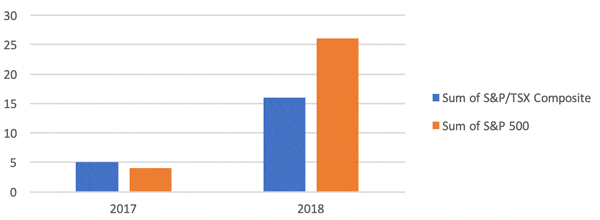As we approach the end of the year, it’s natural to take stock of how everything in our life is going: family, health, wealth and more. But when we reflect back, we may find that our wealth, at least that part which is tied to the stocks markets, probably hasn’t performed all that well in 2018. The major Canadian and U.S. indexes are sharply negative for the year, a far cry from the strong 2017 returns. And a quick look at the rest of the world shows that most International Developed and Emerging stock markets have fallen, down 10% or more. Bonds have also had a below average year. With Central Banks hiking rates in both countries, bond prices have been under pressure from rising yields.
Yet these results don’t jive with the expectations coming into the year. In December 2017, Barron’s published their expert forecasts for 2018 returns in an article which ended: “So long as earnings are rising, rates are low, volatility is subdued, and every stock selloff is met with more buying, as happened again this past week, the bull will still rule over Wall Street.” While estimates varied, all 10 experts questioned for the article forecasted higher returns, with an average gain of 7% on the S&P 500. And these forecasts came out before the U.S. corporate and personal tax cuts were passed at the end of the year.
Coming off a calm 2017 with solid returns around the globe, strong economies in North America, and tax cuts fueling companies’ bottom lines, what wasn’t to be excited about? In fact, 2017 was so tranquil, it was easy to get lulled to sleep thinking markets were a smooth escalator going up.
Yet at both the beginning and end of 2018, markets were impacted by worries of higher interest rates, increasing trade tensions, and doubts about the sustainability of phenomenal growth in the tech sector. Even as economies remain strong in North America, markets are forward looking and fears about a recession in the next 18 months have grown.
Those worries were reflected in day to day market performance over the course of the year. As we can see in the chart , in 2017, investors in Canada and the U.S. saw 5 or fewer days with losses in excess of 1%, which is extremely low compared to historical norms. In 2018, though, with a couple of weeks of trading left in the year, we’ve already seen 26 days with a loss greater than 1% in the U.S. and 16 such days in Canada.
Count of days in which Stock Market declined by more than 1%
Jan 1 ,2017 – Dec 7, 2018

Returns on most asset classes in 2017 were above historical averages, but in 2018 almost all will be below. By the time the year ends, most investors will look at 2018 and could see negative returns and think the year was a disappointment. While below average market returns are indeed disappointing, it’s rare that we ever do hit that exact average. But that’s what makes up those long-term averages. We witnessed positive returns of just 2.1% for the S&P 500 in 2011 and 1.4% in 2015, yet the average return over the 10 calendar years starting with a very poor 2008 was still 8.5%.
We can’t control what the market returns will be, but we can do several things to ensure we’re capturing as much of those returns as possible:
- Determine the right overall asset allocation for your long-term objectives and risk tolerance
- Create custom portfolios for you which blend stocks and bonds from a variety of distinct asset classes
- Utilize the most efficient implementation options possible
- Reduce company, sector and country risk by diversifying globally across thousands of companies
- Avoid overconfidence when markets are rising, and panicked selling when markets are falling
- Ensure that our financial planning projections are using prudent long-term estimates which account for up and down years along the way
In January we’ll have our quarterly recap out and will touch on the final numbers for 2018, and we’ll continue with ongoing communications throughout the year. If you have any questions, or topics you’d like to see us cover, don’t hesitate to ask.